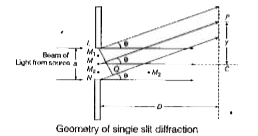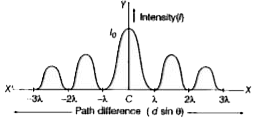Explain qualitatively single slit diffraction pattern showing the intensity distribution pattern .
Text Solution
A parallel beam of light with a plane wavefront is made to fall on a single slit LN .As width of the slit LN = a is of the order of wavelength of light ,therefore diffraction occurs when beam of light passes througth the slit .
The wavelets from the single wavefront reach the centre C on the screen in same phase,Hence ,interfere constructively to give central maximum (bright fringe).
The diffraction pattern obtained on the screen consists of a central bright band ,having alternate dark and weak bright bands of decreasing intensity on both sedes.

Consider a point P on the screen at which wavelet travelling in a direction , make an angle θ with MC .The wavelets from points L and N will have a path difference equal to NQ . From the right angled ΔLNQ , we have
NQ=LNsinθ
or NQ=asinθ
To establish the condition for secondary minima ,the slit is divided into 2,4,6,... equal parts such that correcponding wavelets from successive regions interfere with path difference of λ/2 .
Or for nth secondary minima ,the slit can be divided into 2n equal parts.
Hence ,for nth secondary minima ,
Path difference =a2sinθ=λ2
or sinθn=nλa,(n=1,2,3,...)
To establish the condition for secondary maxima,the slit is divided into 3,5,7 ,... equal parts such that corresponding wavelets from alternate regions interfer with path difference of λ/2 .
Or for nth secondary maxima ,the slit can be divided into (2n+1) equal parts.
Hence ,for nth secondary maxima ,
asinθn=(2n+1)λ2 [n=1,2,3...]
or sinθn=(2n+1)λ2a
Hence ,the diffraction pattern can be graphically shown as below

The point C corresponds to the position of central maxima .And the position −3λ,−2λ,−λ,λ,2λ,3λ.... are secondary minima . the above conditions for diffraction maxima and minima are exactly reverse of mathematical conditions for interference maxima and minima.
|
Updated on:21/07/2023
Similar Questions
Knowledge Check
- Question 1 - Select One
In single slit diffraction pattern :
Acentral fringe has negligible width than othersBall fringes are of some widthCcentral fringe does not existDnone of the above - Question 2 - Select One
In single slit diffraction pattern :
ACentral fringe has negligible width than othersBAll fringes are of same widthCCentral fringe does not existDNone of the above - Question 3 - Select One
In a single slit diffraction pattern
ACentral fringe has negligible width than othersBall fringes are of same widthCCentral fringe do not existDcentral fringe is twice as wide as other maxima
In deriving the single-slit diffraction pattern, it was states that the intensity is zero at angles nλa. Justify this by suitable dividing the slit to bring out the cancellation.
View SolutionIn a single slit diffraction pattern intensity and width of fringes are
View SolutionIn a single slit diffraction pattern, which of the following is incorrect for fringe pattern?
View SolutionNo fringes are seen in a single-slit diffraction pattern if
View SolutionThe fringe width in single slit diffraction pattern is proportional to
View Solution

